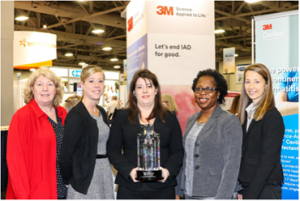By Cyndi LaFond, PhD, RN, CCRN-K
On May 20th, the University of Chicago Medicine Nursing Skin Care Team was awarded the Sixth Annual 3M Award for Excellence in Skin Safety at the Wound, Ostomy, and Continence Nurses Society Conference in Salt Lake City, Utah. Led by Susan Solmos MSN, RN, CWCN the team was recognized for their achievements in preventing skin injury over the past four years, including an 83% reduction in hospital acquired pressure ulcers (HAPU).
So how did the nursing team achieve and sustain this remarkable achievement? They have incorporated findings from the science of healthcare delivery (and some research fundamentals) into their program.
#1 Are you measuring what you think you are measuring?
There is likely nothing more widely appreciated, in any type of inquiry, than the need for valid and reliable outcome measures. Yet, data sources from real world practice bring many challenges, including multiple contributors with varying skillsets and knowledge. When Susan first came to UCM 4 years ago, she identified inconsistencies in clinicians’ ability to differentiate pressure injury from other types of skin damage – especially moisture associated skin damage (MASD). This differentiation is crucial as treatment is guided by the origin of skin damage and injuries from pressure specifically are tied to quality metrics, reimbursement, and can lead to litigation. Implementation of structured training, evaluation of skin care nurses’ wound assessments, and validation of every potential HAPU case by certified wound care nurses (CWCNs) during prevalence days contributed to the considerable reduction of UCM’s HAPU rates and brought to light the need to further address MASD for our patients. The team now also tracks MASD during prevalence days and has added special moisture wicking pads to our arsenal of skin prevention products.
#2 Engage the End-User
Involvement of end-users is consistently described in implementation research. At a minimum, end-users are queried to help identify barriers to translation, but often they are integrated into the team as change champions. For years UCM has had a skin care team consisting of clinical nurses who participate in continuing education activities and evaluate patients during skin prevalence days. However, in recent years, efforts have been made to further engage and expand the team. New opportunities have been  provided for nursing support assistants to participate in the skin care team and for longstanding members to become “senior” skin team members. Senior skin team members are focused on change across the organization and are offered additional opportunities to advance their clinical skills, train others in skin prevention, and engage in scholarly activities. As a result, UCM’s Skin Care Team has grown from 24 to 89 individuals, extending our expertise across the organization.
provided for nursing support assistants to participate in the skin care team and for longstanding members to become “senior” skin team members. Senior skin team members are focused on change across the organization and are offered additional opportunities to advance their clinical skills, train others in skin prevention, and engage in scholarly activities. As a result, UCM’s Skin Care Team has grown from 24 to 89 individuals, extending our expertise across the organization.
#3 Combined Approaches are More Effective
While education is an important component to improvements in patient care, combined approaches have repeatedly demonstrated to be more effective. The delivery of patient care is complex, and individual knowledge alone is likely insufficient to overcome system barriers. Skin care efforts at UCM have included continuing education offerings for employees, training for new employees, and targeted reinfusions of training to nurses based on unit-level prevalence results. However, efforts have also included engagement of change champions (skin care team members) and hospital leaders, dissemination of decision-support materials, the introduction of products/equipment supported by research findings, and the evaluation of medical supplies (for example, new oxygen masks) for the increased risk of medical device related pressure ulcers prior to institutional purchase.
The sustained success of our HAPU rates at UCM is the result of relentless pursuit of knowledge – in an understanding of the problem, the indicated interventions, and the best approach to integrate and sustain changes in our delivery of patient care.
